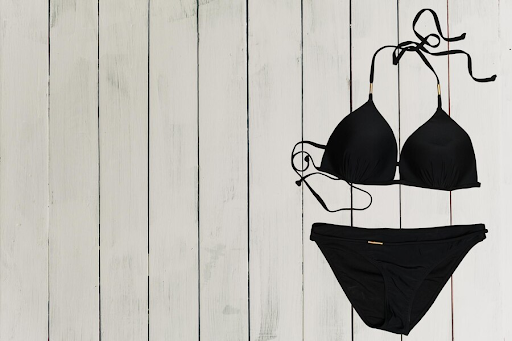The Ideal Fabric for Bathing Suits

Swimming is an excellent activity to get fit and have fun at the same time. Since summer is on its way, for sure you’re looking forward to having a good time at a pool or beach. Trust us when we say now is the best time to start thinking about your new bathing suit.
However, many fabric choices might overwhelm you. Fortunately, here’s an article to help you decide which swimwear fabric among wholesale bathing suits selection is perfect for your needs.
Let’s check them out! Here’s a list of well-known fabrics used for making bathing suits.
Table of Contents
Natural Fabrics
Interestingly, bathing suits were created from natural fibers way before synthetic Lycra or stretchy fibers were invented. What’s astonishing is that wool was one of the well-known materials used in swimwear making. This makes sense though since it has a particular amount of elasticity, making it an ideal choice for knitted close-fitting swimwear.
Wool was also accessible and affordable at that time. More than that, there were knitting patterns available from fashion magazines that enabled swimmers to knit their swimming costumes. Although it was somewhat bizarre compared to present-day fashion, it was all they had back then, when Spandex and Lycra were not yet discovered.
Like other natural fibers, wool has the tendency to expand once soaked in water. This makes them become heavy, even stretch out of shape, none of which are good traits in terms of producing swimwear. Surprisingly, with nowadays push for more eco-friendly solutions, wool and poly-cotton combinations are slowly getting back into swimwear production. However, it will still be a long way to go for natural materials to come close with synthetic materials.
Synthetic Fabrics
Technically, it will be an endless list if we’re going to enumerate all the synthetic fibers and blends of fibers. Synthetic fabrics are overflowing with the most important qualities today’s swimsuits need to function in fashion arenas, especially in competitive sports.
Polyester, the number one selection when it comes to suitable synthetic fabrics, has a built-in resistance to sunlight and chlorine. What’s more, once blended with elastane’s elasticity, it’s durable, manageable to care for. All of these intrinsic features of polyester make it an ideal choice for making two piece bathing suit swimwear.
List of Best Swimsuit Materials
Polyester
As mentioned above, polyester is one of the well-known fabrics in apparel manufacturing due to its durability, manageability, UV and chlorine resistance, and softness. Also, it has quick-drying attributes plus longevity, making it an excellent selection for bathing suits, like for competitive swimming.
-
Advantages
- Colorfast and durable
- Resistant to ultraviolet light and chlorine
- Manageable and easy to wash since it holds its form well
- Moisture resistant
-
Disadvantages
- Not sustainable to the environment
- Quality may be affected
- Elastane
In the late 1950s, elastane was developed for apparel use, plus it is the generic term used for the elastic fabric found in known brands, such as Spandex and Lycra. Technically, elastane, like polyurethane (100% synthetic material), is introduced to the market as an alternative to natural rubber.
What’s fascinating is that it can be added to natural fibers to provide fabrics with a better stretch, making it a perfect garment for swimwear.
- Advantages
- Very flexible and stretchy
- Creates attractive silhouettes since this garment is form-fitting
Moisture-wicking feature
- Disadvantages
-
-
- Can be really expensive
- Not biodegradable
- Requires an in-depth and rigorous production process
-
- Nylon
Nylon, or polyamide, is a quick-drying and water-resistant fabric material. It’s primarily seen in fashion swimwear since it’s comfortable, soft, and flattering to wear. More than that, this fabric can be figure-hugging once mixed with elastane, which can be a big help to hide body fullness.
-
Advantages
- Durable and easy to wash
- Comfortable to wear
- Soft and highly stretchable
-
Disadvantages
- Not resistant to UV rays
- Can be quickly damaged by chlorine
- There is a tendency to experience color bleed, so they are not applicable for printed designs
-
PBT (Polybutylene Terephthalate)
Polybutylene Terephthalate, better known as PBT, is a plastic yarn fiber that possesses a natural stretch and recovery feature. Although PBT is considered a member of the polyester family of plastics, it is not as elastic as the others. In fact, its texture is stiffer, but with a light and smooth texture.
-
Advantages
- Very resistant to chlorine and other chemicals
- Comfortable to wear and resistant to pilling and snagging
- Resistant to moisture which allows the swimwear to quickly dry
- Resistant to UV light and colorfast
-
Disadvantages
- Not eco-friendly since it is petroleum-based
- Has less elastic property compared to other polyester-based fabrics
Conclusion
Choosing the ideal bathing suit by taking note of the best fabric among all could be a challenge for you. Yet knowing where to start to complement your needs will help you find the perfect swimwear with confidence. We hope this article has been a great assistance to you.
For any important information please contact us Email GadgetsNg info@gadgetsng.com
[Button id="1"]




Thanks for sharing. I read many of your blog posts, cool, your blog is very good. https://accounts.binance.com/sl/register?ref=PORL8W0Z
Thank you for your sharing. I am worried that I lack creative ideas. It is your article that makes me full of hope. Thank you. But, I have a question, can you help me?